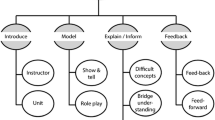Abstract
This article describes a model for training instructional designers who will work as members of a videodisc development team. The model develops and integrates a complex set of skills that range from planning and design to programming and production. Its purpose is to train designers who can envision the many facets of disc development—designers who can converse intelligently, creatively, and efficiently with other specialists. The model is implemented, over a 15-week period, through a sequence of intense and highly coordinated activities. These build rapidly from relatively simple tasks that omit many aspects of disc development to a complex collaborative undertaking that includes, in simplified form, all of the major elements involved in creating a disc from scratch.
Similar content being viewed by others
References
Allen, B. S. (1986). Interactivating linear video.Journal of Computer-Based Instruction.13(4), 107–112.
Currier, R.L. (1983). Interactive videodisc learning systems.High Technology.3(11), 51–59.
DeBloois, M.L. (1982). Principles for designing interactive videodisc instructional materials. In M.L. DeBloois (Ed.),Videodisc/microcomputer courseware design. Englewood Cliffs, NJ: Educational Technology Publications.
DeBloois, M. L. (1984). Effectiveness of interactive videodisc training: A comprehensive review.The Monitor Report Series. Falls Church, VA: Future Systems Incorporated.
Glasgow, Z., & Edmodson, J. (1985). Use of videodisc to train managers how to manage the ISD process.Proceedings for the 7th Annual Conference on Interactive Videodisc in Education and Training (pp. 23–26). Warrenton, VA: Society for Applied Learning Technology.
Holzmann, J. (producer) & Benz, F. (director). (1981).The Creative Camera [Videodisc]. Montvale, NJ: Pioneer Electronic Corporation & Valley Isle Productions.
Merrill, M.D. (1983). Component display theory. In C.M. Reigeluth (Ed.)Instructional design theories and models. Hillsdale, NJ: Lawrence Erlbaum Associates.
Miller, R.L., & Sayers, J.H. (1985). The US videodisc market: Analysis and forecasts to 1990.The Monitor Report Series A151185. Falls Church, VA: Future Systems, Incorporated.
Willrett, D., & Young, S. (1984).MacProject [Computer program]. Cupertino, CA: Apple Computer, Inc.
Author information
Authors and Affiliations
Additional information
Author Notes
Teaming Tomatoes, this years’ class project, won a silver “Cindy” award for excellence in Level 3 video disc design from the Association of Visual Communicators.
Rights and permissions
About this article
Cite this article
Allen, B.S., Erickson, D.M. Training interactive videodisc designers. Journal of Instructional Development 9, 19–28 (1986). https://doi.org/10.1007/BF02905210
Issue Date:
DOI: https://doi.org/10.1007/BF02905210




